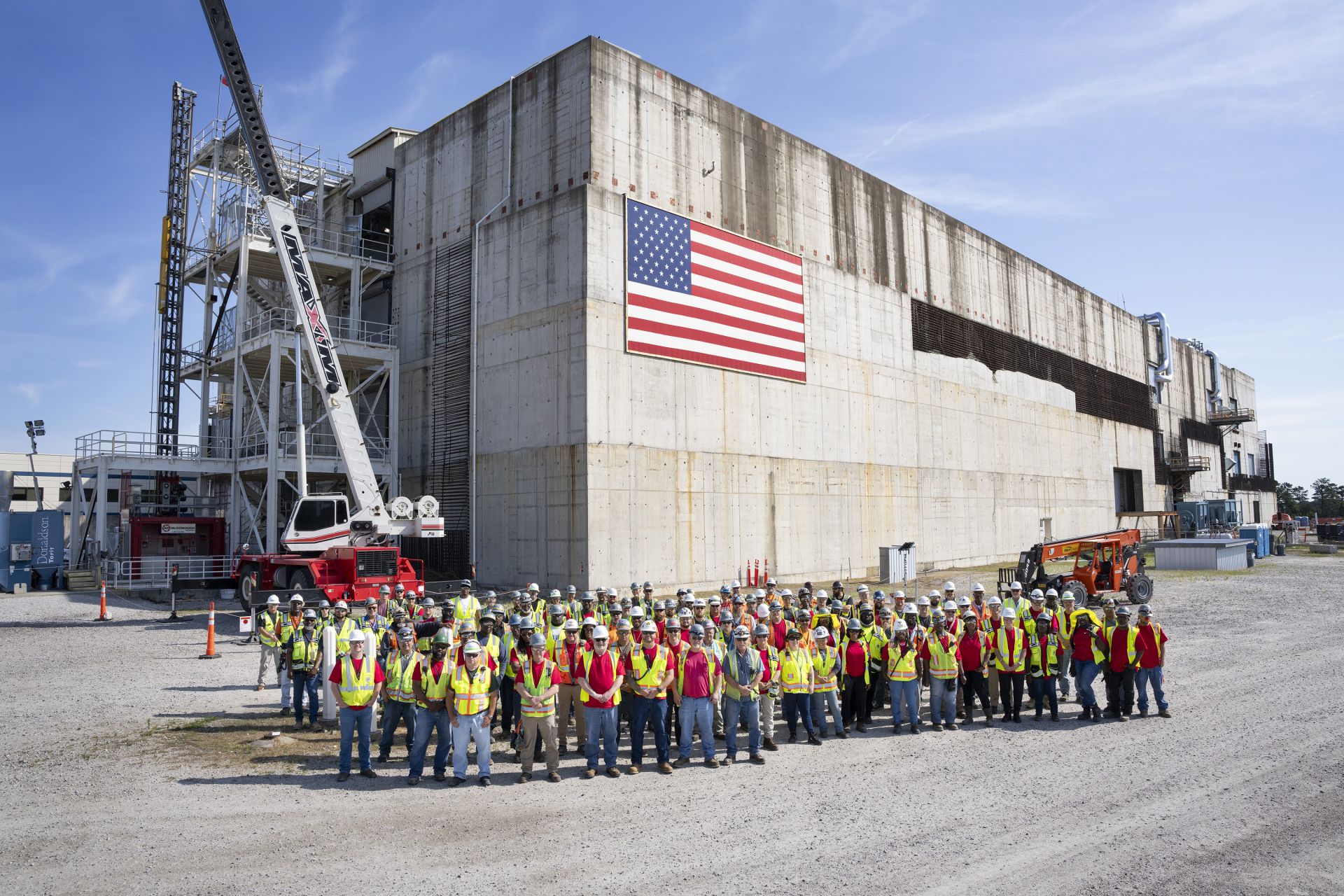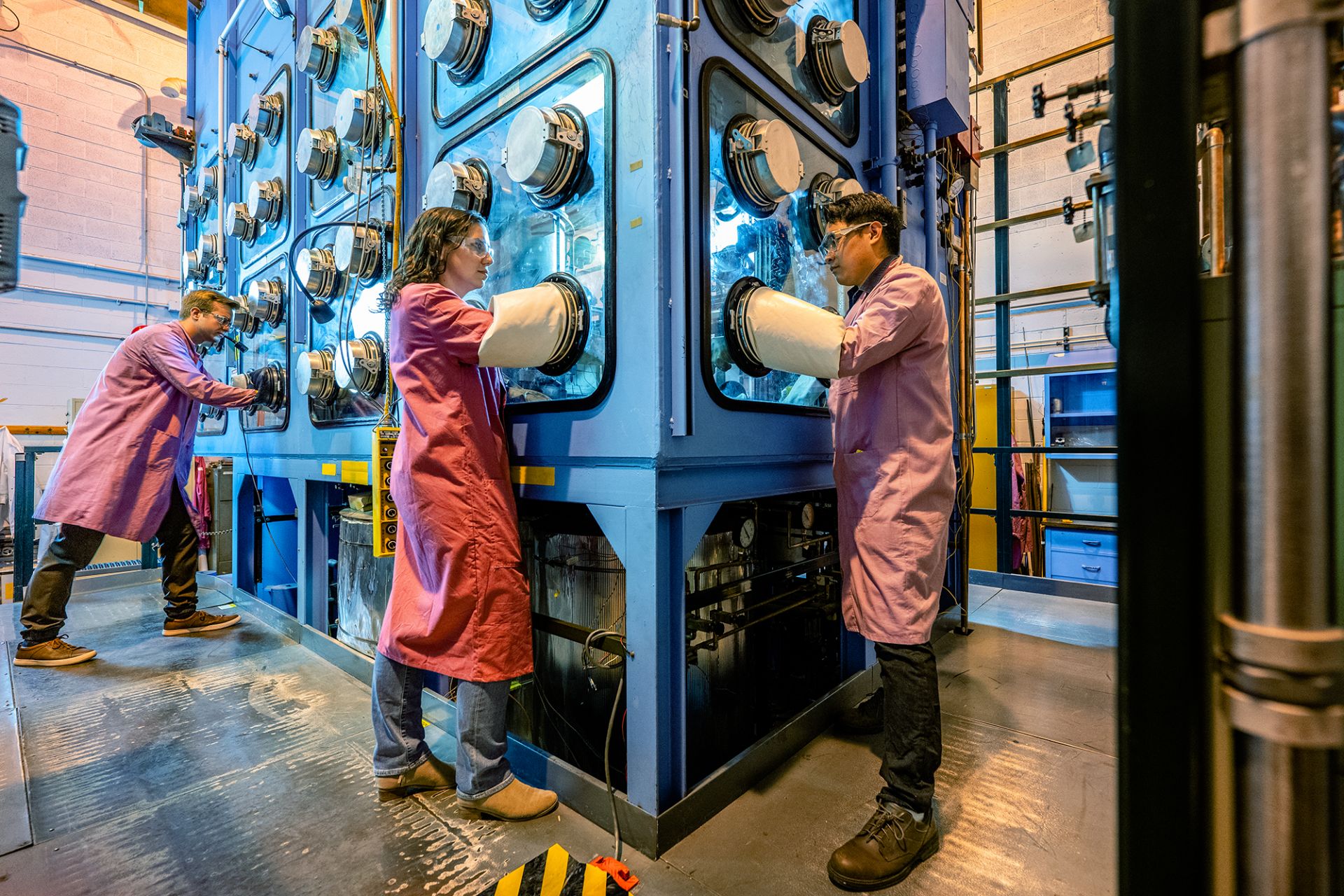The ALCF AI Testbed includes the AI systems represented in this collage: Cerebras, Graphcore, Groq, and SambaNova. (Image: Argonne National Laboratory)
Generative artificial intelligence paired with advanced diagnostic tools could detect potential problems in nuclear power plants and deliver a straightforward explanation to operators in real time. That’s the premise of research out of the Department of Energy’s Argonne National Laboratory, and just one example of the DOE’s increasing exploration of AI applications in nuclear science and technology research. Training and restraining novel AI systems take expertise and data, and the DOE has access to both. According to a flurry of reports and announcements in recent months, the DOE is setting out its plans to ensure the United States can use AI to its advantage to enhance energy security and national security.
The Atlas railcar carries a simulated shipment of spent nuclear fuel during testing in September 2023. (Photo: DOE)
The Department of Energy has issued a request for information to gather input on its proposed package performance demonstration, which is intended to demonstrate the robustness of spent nuclear fuel transportation casks in hypothetical accident conditions. By simulating severe accident scenarios, the DOE said it intends to show to the public and stakeholders the safety and reliability of transporting SNF by rail, heavy-haul truck, and barge.
Workers begin construction at the Hermes site in Oak Ridge, Tenn. (Photo: Kairos Power)
Earlier today, on a site in Oak Ridge, Tenn., that was formerly home to the K-33 Gaseous Diffusion Plant, Kairos Power marked the start of construction on its low-power demonstration reactor. Named Hermes, the 35-MWt test reactor claims status as the first Gen IV reactor to be approved for construction by the Nuclear Regulatory Commission and the first non–light water reactor to be permitted in the United States in more than 50 years.
Locations of DOE-EM cleanup sites. (Map: GAO)
Despite efforts to increase hiring, the Department of Energy’s Office of Environmental Management continues to be understaffed, according to a recent Government Accountability Office report. The GAO found that, at the end of fiscal year 2023, DOE-EM had 263 vacant positions across its headquarters, cleanup sites, and EM Consolidated Business Center—a vacancy rate of 17 percent. The office is responsible for the cleanup of the environmental legacy waste resulting from decades of nuclear weapons production and government-sponsored nuclear energy research.
Aecon-Wachs workers performed the D&R of equipment and commodities from the plutonium processing facility at SRS. ( Photo: SRS)
A major milestone has been reached in the construction of a plutonium pit production facility at the Savannah River Site, located near Aiken, S.C.
After 18 months of work involving local trade unions, the dismantlement and removal (D&R) of commodities and equipment throughout the Savannah River Plutonium Processing Facility (SRPPF), previously installed by the Mixed Oxide (MOX) project, was completed in June 2024, the Department of Energy reported on July 24.
Engineers in Argonne’s Chemical and Fuel Cycle Technologies Division. (Photo: Argonne National Laboratory)
Oklo Inc. announced that it has completed the first end-to-end demonstration of its advanced fuel recycling process as part of an ongoing $5 million project in collaboration with Argonne and Idaho National Laboratories. Oklo’s goal: scaling up its fuel recycling capabilities to deploy a commercial-scale recycling facility that would increase advanced reactor fuel supplies and enhance fuel cost effectiveness for its planned sodium fast reactors.
INL’s new Bitterroot supercomputer installed in the Collaborative Computing Center. (Photo: INL)
A new supercomputer named Bitterroot started operating in June at Idaho National Laboratory’s Collaborative Computing Center (C3) and is speeding up nuclear energy research by improving access to modeling and simulation tools. Bitterroot arrived at INL in March, and the announced July 15 that the supercomputer was open to users on June 18 after installation and an extensive program of testing.
SiGA woven silicon carbide nuclear fuel cladding. (Photo: DOE)
Because of its hardness and its hardiness in the face of high temperatures, silicon carbide has been used for industrial purposes for decades. It has proven its worth as a key component of tiny TRISO fuel particles. But SiC has a weakness—in its pure form it is too brittle for use in structural components, such as 12-foot-long light water reactor fuel cladding tubes.
SRS Apprenticeship Program graduates Terrence Tillman (far right) and Shanterra Hughes share their recent apprenticeship experiences with NPR host David Brancaccio (center) and NPR sound engineer Rebekah Wineman. (Photo: DOE)
A new radio series on National Public Radio’s “Marketplace Morning Report” recently highlighted career opportunities and job training at the Department of Energy’s Savannah River Site.
To listen to the radio segment, click here.
The waste management panel, from left: moderator Todd Allen, Fred Dilger of Nevada, Katrina McMurrian of the NWSC, the DOE’s Paul Murray, Jenifer Shafer of ARPA-E, and Kuhika Gupta of the University of Oklahoma. (Photo: ANS)
With increasing demand for clean, reliable, and safe sources of energy, the conversation around nuclear energy is changing. And so too is the conversation around nuclear waste, even as the country struggles to find a path for the disposal of its spent nuclear fuel and high-level radioactive waste. From community engagement, to recycling, to existing success around other forms of nuclear waste management, the conversation around nuclear waste has many different angles, and an executive session of the American Nuclear Society’s 2024 Annual Conference in Las Vegas aimed to delve into some of those discussions.
Kyle Reed and Dianne Ezell of ORNL gather data about the performance of a sensor transistor as it is tested against the radiation within the reactor pool behind them at Ohio State University’s Nuclear Reactor Laboratory. (Photo: Michael Huson/The Ohio State University)
Researchers at the Department of Energy’s Oak Ridge National Laboratory want to make the sensors in nuclear power plants more accurate by linking them to electronics that can withstand the intense radiation inside a reactor. Electronics containing transistors made with gallium nitride, a wide-bandgap semiconductor, have been tested in the ionizing radiation environment of space. Now, according to a June 24 article from ORNL, tests carried out in the research reactor at Ohio State University indicate they could withstand neutron bombardment within a nuclear fission reactor.
Entergy’s River Bend in St. Francisville, La., a boiling water reactor and one of five Entergy nuclear power reactors. (Photo: Entergy)
The Department of Energy’s Gateway for Accelerated Innovation in Nuclear (GAIN) announced June 20 that two companies—one power plant operator and one advanced reactor developer—are getting vouchers to access the extensive nuclear research capabilities and expertise available across the DOE national laboratories in the third round of GAIN vouchers awarded for fiscal year 2024.
SRS firefighters responded to a staged scene outside of K Area’s Criticality Control Overpack pad. The firefighters followed an Incident Action Plan to maximize the safety of responders and role-playing victims for effective extraction. (Photo: DOE/SRNS)
Earlier this month, nearly 250 personnel at the Department of Energy’s Savannah River Site in South Carolina took part in an annual exercise to test preparedness for a radiological release and contamination emergency.
.png)

















